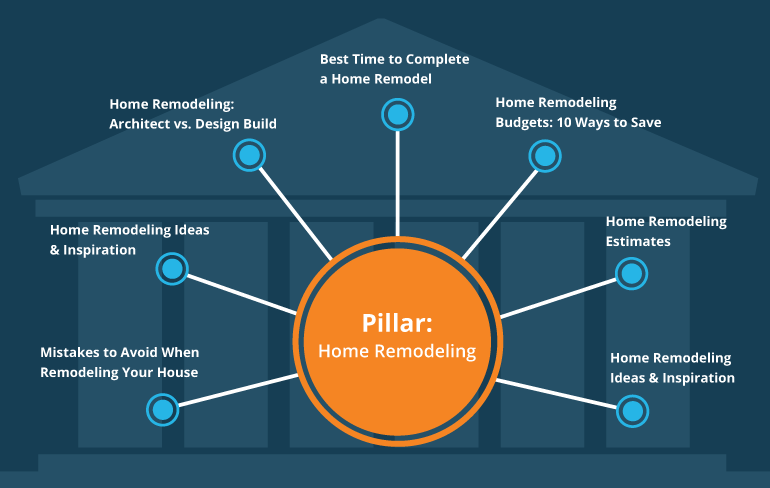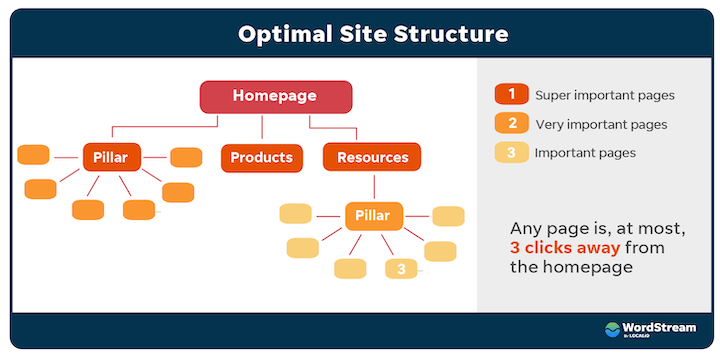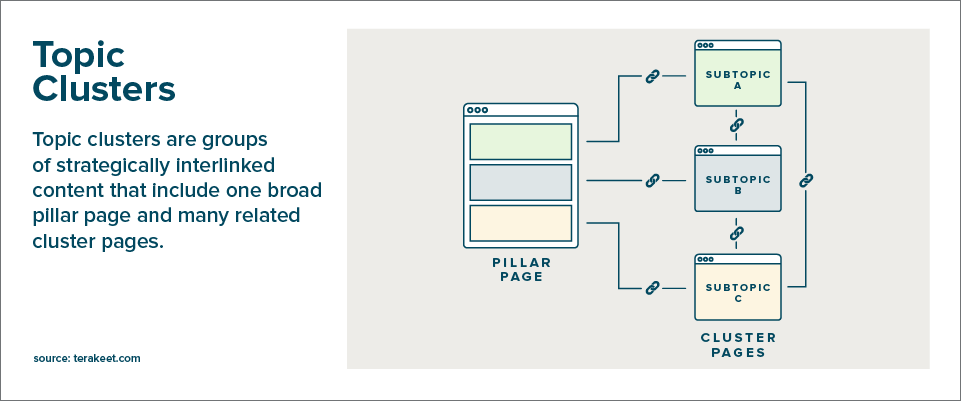Discover the untapped potential of a pillar page and revolutionize your content strategy with this game-changing SEO technique.

Image courtesy of via DALL-E 3
Table of Contents
- Introduction to Pillar Pages
- Choosing a Topic for Your Pillar Page
- Creating Content for Your Pillar Page
- Linking Subtopics to Your Pillar Page
- Optimizing Your Pillar Page for SEO
- Formatting Your Pillar Page
- Updating and Maintaining Your Pillar Page
- Examples of Successful Pillar Pages
- Summary and Conclusion
- Frequently Asked Questions (FAQs)
Introduction to Pillar Pages
Are you curious about how to make your blog more organized and structured? That’s where pillar pages come into play! In this section, we’ll introduce you to the concept of a pillar page and why it’s essential for creating well-structured blog content. Let’s dive in!
What is a Pillar Page?
So, what exactly is a pillar page? Think of it as the main hub of your blog. It’s like the big topic that covers all the essential information, and then branches out into more specific subtopics. A pillar page acts as the foundation for your blog content, helping to keep everything in a neat and organized structure.
Why Use Pillar Pages?
Using pillar pages in your blog can bring a lot of benefits. Firstly, it helps you organize your content in a way that makes it easier for readers to navigate and find what they’re looking for. Additionally, search engines love well-structured content, so having a pillar page can also boost your SEO (Search Engine Optimization) efforts. By creating pillar pages, you can showcase your expertise in a particular topic and establish yourself as a trusted source of information.
Choosing a Topic for Your Pillar Page
When creating a pillar page for your blog, one of the most crucial steps is choosing the right topic. Your topic will serve as the foundation of your pillar page, so it’s important to select something that is relevant, engaging, and valuable to your readers. Here are some tips to help you pick the perfect topic for your pillar page.
Think About Your Audience
Before you start brainstorming topic ideas, take some time to consider your audience. Who are they? What are their interests, challenges, and needs? Understanding your audience will help you narrow down topics that will resonate with them and provide them with valuable information. Remember, your pillar page should address a specific pain point or topic that your audience cares about.
Research Trending Topics
One effective way to choose a topic for your pillar page is to research trending topics in your industry or niche. There are various research tools available that can help you identify popular subjects that are currently generating buzz. By tapping into these trends, you can create content that is timely and relevant, increasing the likelihood of attracting more traffic to your pillar page.
Creating Content for Your Pillar Page
When it comes to developing content for your pillar page, it’s crucial to follow a structured approach that aligns with the overarching theme of your blog. Let’s delve into the steps you can take to craft engaging and informative articles that fit seamlessly within your pillar page format.

Image courtesy of theblogpilot.com via Google Images
Start with Broad Topics
Begin by identifying broad topics that encompass the main ideas you want to cover in your pillar page. These topics serve as the foundation on which you can build detailed subtopics and articles. For instance, if your blog focuses on healthy living, a broad topic could be “Nutrition Tips for a Balanced Diet.”
Use Clear Headers and Sections
Once you’ve defined your broad topics, it’s essential to organize your content using clear headers and sections. This not only enhances the readability of your pillar page but also makes it easier for readers to navigate through the information. Consider using descriptive headers that outline the key points you’ll be discussing in each section.
Linking Subtopics to Your Pillar Page
Subtopics are like smaller pieces of a puzzle that fit together to create a bigger picture. In the world of blogging, subtopics are the specific subjects or themes that you cover within your main pillar page topic. They help to break down the main idea into more manageable sections, making it easier for readers to navigate and understand the content.
How to Create and Link Subtopics
Creating subtopics for your pillar page involves identifying the key areas or aspects that you want to delve into further. Once you have your subtopics outlined, it’s essential to link them back to your main pillar page. This internal linking strategy is not only helpful for your readers to explore related content easily but also plays a crucial role in SEO.
Optimizing Your Pillar Page for SEO
When creating a pillar page for your blog, it’s essential to optimize it for search engines to ensure that your content gets the visibility it deserves. Here are some strategies to help you optimize your pillar page for SEO:

Image courtesy of neilpatel.com via Google Images
Using Relevant Keywords
Keywords are the words or phrases that people type into search engines to find information. To improve your pillar page’s SEO, it’s crucial to use relevant keywords strategically throughout your content. Make sure to include your main keyword in the title, headers, and body of your pillar page. This will help search engines understand what your page is about and rank it higher in search results.
Adding Meta Tags and Descriptions
Meta tags and descriptions provide a brief summary of your content to search engines and users. Including relevant keywords in your meta tags and descriptions can improve your pillar page’s visibility in search results. Make sure to write compelling meta tags and descriptions that accurately describe the content of your page while also enticing users to click on it.
Formatting Your Pillar Page
When it comes to creating a pillar page, it’s not just about the content you include—it’s also about how you present that information. Proper formatting plays a crucial role in ensuring that your pillar page is easy to read, visually appealing, and engaging for your audience. Here are some key tips on how to format your pillar page effectively.
Use Bullet Points and Lists
One of the best ways to enhance the readability of your pillar page is by using bullet points and lists. Bullet points are great for highlighting key points or listing out important information in a concise and structured manner. Lists can help break up large blocks of text, making it easier for readers to scan through the content and find what they’re looking for. By incorporating bullet points and lists, you can improve the overall organization and clarity of your pillar page.
Incorporate Images and Media
Visual elements such as images, videos, and infographics can greatly enhance the appeal of your pillar page. Not only do they make the content more engaging and interesting for readers, but they also help to break up the text and add visual interest. Including relevant images and media can help to illustrate key points, provide examples, and make complex concepts easier to understand. By incorporating a mix of text and visual elements, you can create a dynamic and compelling pillar page that keeps readers hooked.
Updating and Maintaining Your Pillar Page
Once you have created your pillar page, the work doesn’t stop there. It’s essential to keep your content fresh and relevant by updating and maintaining your pillar page regularly. This ensures that your audience always has access to the most up-to-date information and helps improve your search engine rankings.

Image courtesy of www.wordstream.com via Google Images
Regularly Review Content
It’s crucial to regularly review the content on your pillar page to check for any outdated information, broken links, or any sections that need improvement. By keeping your content current, you show your audience that you are committed to providing them with accurate and valuable information.
Add New Information
Adding new segments or data to your pillar page can help keep it relevant and engaging for your readers. Whether it’s new research findings, updated statistics, or recent industry trends, incorporating fresh information into your pillar page demonstrates your expertise and authority in your niche.
Examples of Successful Pillar Pages
When it comes to creating effective pillar pages, looking at successful examples can provide valuable insights and inspiration. Let’s explore some popular blogs that have mastered the art of pillar pages and understand why these examples work so well.
Exploring Popular Blogs
One notable example of a successful pillar page is HubSpot’s “The Ultimate Guide to Marketing Campaigns”. This comprehensive pillar page covers various aspects of marketing campaigns, from strategy development to execution and measurement. By breaking down complex topics into easily digestible sections, HubSpot ensures that readers can navigate through the content effortlessly.
Another excellent example is Moz’s “SEO Learning Center”. This pillar page serves as a one-stop resource for anyone looking to enhance their SEO knowledge. With clear headers, subtopics, and internal links, Moz has organized vast amounts of information in a user-friendly manner. The inclusion of high-quality images and videos also makes the content engaging and visually appealing.
Why These Examples Work
These successful pillar pages work for several key reasons. Firstly, they focus on addressing a specific topic in-depth, providing comprehensive information that covers all aspects of the subject matter. By structuring content effectively with clear headers, subtopics, and internal links, these pillar pages ensure seamless navigation for readers.
Moreover, the inclusion of relevant keywords and meta tags helps optimize these pillar pages for search engines, improving their visibility and reach. Incorporating visual elements like images, videos, and infographics enhances the overall user experience and keeps readers engaged throughout their exploration of the content.
By examining these examples of successful pillar pages, blog creators can gain valuable insights into how to structure their own content effectively and create a compelling resource for their audience.
Summary and Conclusion
In this article, we have delved into the concept of a pillar page and its significance in creating structured and organized blog content. A pillar page serves as the main hub for a particular topic, encompassing all related subtopics in a comprehensive manner.

Image courtesy of terakeet.com via Google Images
Key Points
First and foremost, we learned that a pillar page is a foundational piece of content that covers a broad topic and links to more specific subtopics. It acts as a guide for readers to navigate through related information efficiently. By choosing a relevant and trending topic, understanding the target audience, and conducting thorough research, you can create a pillar page that resonates with your readers.
Creating content for your pillar page involves starting with broad topics and breaking them down into manageable subtopics. Utilizing clear headers and sections further enhances the readability and organization of your content. Linking subtopics back to the pillar page is crucial for SEO and overall content organization.
Optimizing your pillar page for SEO involves using relevant keywords strategically and incorporating meta tags and descriptions to improve search engine visibility. Formatting your pillar page with bullet points, lists, images, and other media elements enhances the overall readability and engagement for your audience.
Maintaining and updating your pillar page regularly is essential to keep it relevant and informative. By reviewing and adding new information consistently, you can ensure that your pillar page remains a valuable resource for your readers.
Lastly, we explored examples of successful pillar pages to provide inspiration and insight into what makes them work effectively. By analyzing these examples, you can glean valuable tips on creating your own impactful pillar page.
Remember, a well-structured pillar page serves as a cornerstone for your blog content, offering a comprehensive overview of a topic that captures the interest and attention of your audience.
Frequently Asked Questions (FAQs)
What is the main purpose of a pillar page?
A pillar page serves as the central hub of content for a specific topic on a blog. Its main purpose is to organize and structure related information in a comprehensive and accessible manner. By creating a pillar page, you can effectively showcase your expertise on a particular subject while also improving your website’s SEO performance. Additionally, a pillar page can help guide visitors to explore more content on your blog, increasing engagement and time spent on your site.
How often should I update my pillar page?
Updating your pillar page regularly is essential to ensure that it remains relevant and valuable to your audience. The frequency of updates can vary depending on the topic and industry you are covering. It is recommended to review and refresh your pillar page at least every few months to incorporate new information, trends, or data that may have emerged since its creation. By keeping your pillar page up-to-date, you can maintain its credibility and authority in your niche.







